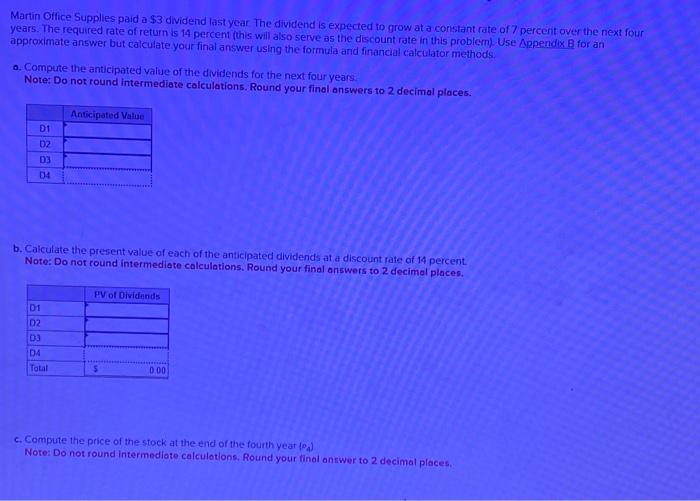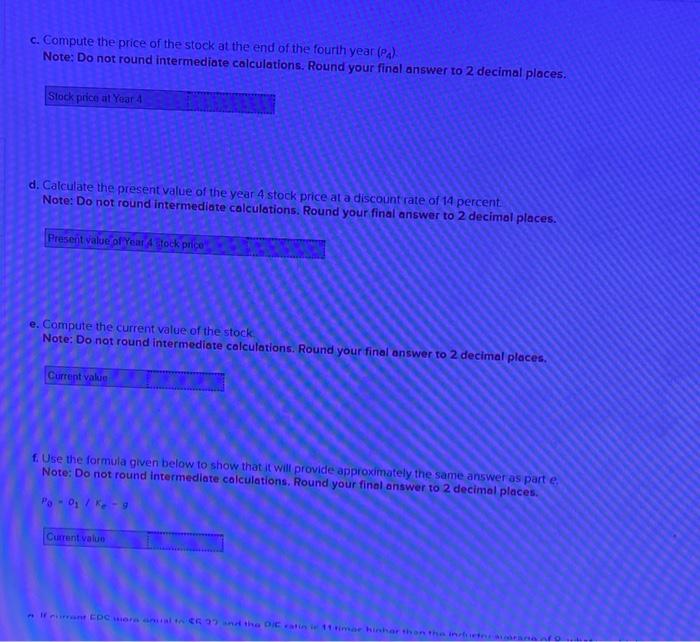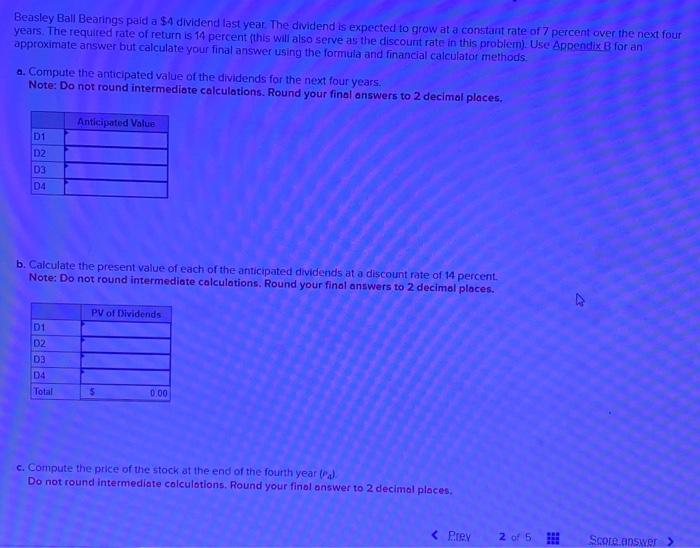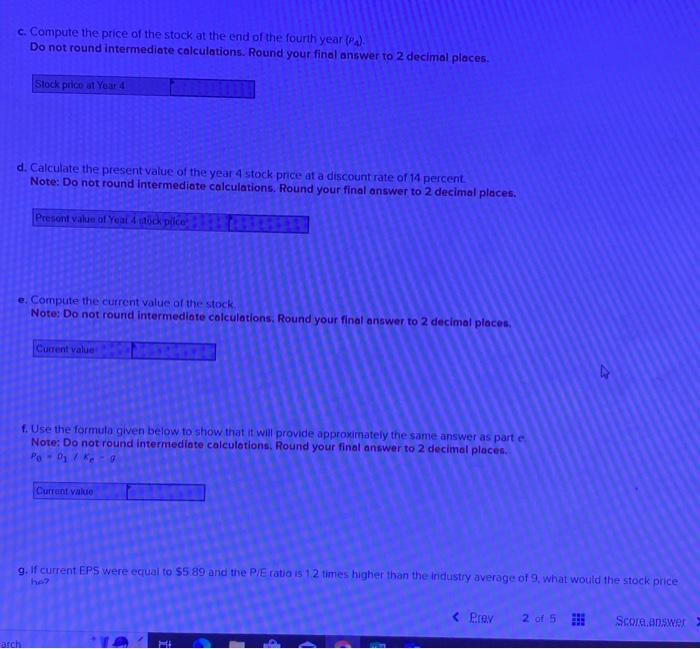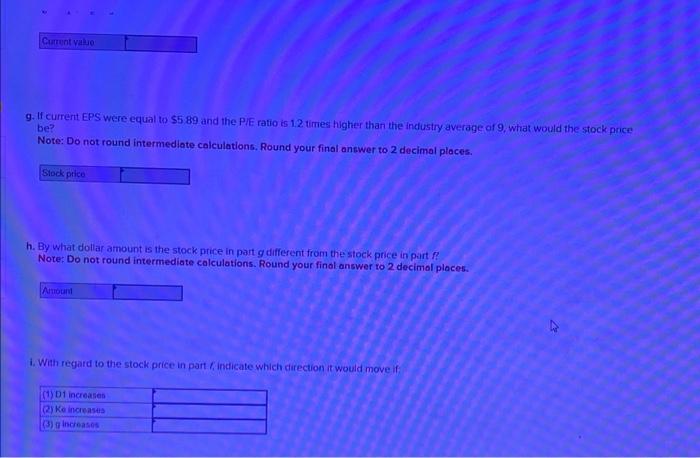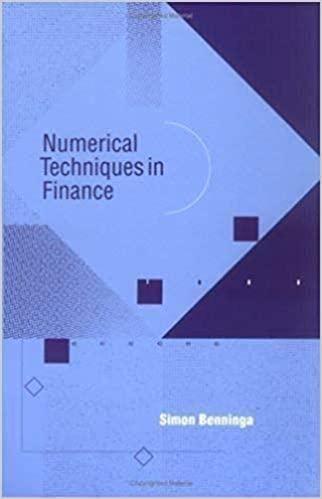Martin Gifice Supplies paid a $3 dividend last year The dividend is expected to grow at a coristant rate of 7 percent over the next four years. The required rate of return is 14 percent (thic will also serve as the discount rate in this problem) Use Appendix B for an approximate answer but calculate your final answer using the formula and financial calculator methods. a. Compute the anticipated value of the dividends for the next four years: Note: Do not round intermediate calculations. Round your final answers to 2 decimal places. b. Calculate the present value of each of the anticipated dividends at a discount rate of 14 percent. Note: Do not round intermediate calculations. Round your final answers to 2 decimal places. c. Compute the price of the stock at the end of the fourth yeat (p4). Note: Do not round intermediate calculotions. Round your linal answer to 2 decimal places. c. Compute the price of the stock at the end of the fourth year (PA). Note: Do not round intermediate calculations. Round your final answer to 2 decimal places. d. Calculate the present value of the year 4 stock price at a discount rate of 14 percent: Note: Do not round intermediate calculations. Round your final answer to 2 decimal places. e. Compute the current value of the stock: Note: Do not round intermediate calculotions. Round your final answer to 2 decimal places. f. Use the formila given below to show thatit will provide approximately the same answer as part e, Note: Do not round intermediate calculations. Round your final answer to 2 decimal places. P0=o1/Keg r. Use me rormula given betow to sniow mat it wil provide approximatefy injesame unsweras patt a Note: Do not round intermediate calculations, Round your final answer to 2 decimal ploces. Pe=D1/xe=D 9. If current EPS were equal to 55.32 and the P: E ratio is 11 times higher than the industry average of 8 , what would the stock price be? Note: Do not round intermediate colculations. Round your finol answer to 2 decimal places. h. By what dollar amount is the stock price in part g different from the stock price in part P Note: Do not round intermediate calculations. Round your final onswer to 2 decimal places. 1. With regard to the stock price in part findicate which direction it would move if Beasley Ball Bearings paid a $4 dividend last year The dividend is expected to grow at a constant rate of 7 percent over the next four years. The required rate of return is 14 percent (this will also serve as the discourit rate in this problem). Use Appendix B for an approximate answer but calculate your final answer using the formuld and financial calculator methods. a. Compute the anticipated value of the dividends for the next four years. Note: Do not round intermediate calculations. Round your final answers to 2 decimal places. b. Calculate the present value of each of the anticipated dividends at a discount rate of 14 percent. Note: Do not round intermediate calculations. Round your final answers to 2 decimol places. c. Compute the ptice of the stock at the end of the fourth year (p4) Do not round intermediate colculotions, Round your finol answer to 2 decimol places, c. Compute the price of the stock at the end of the fourth year (P4). Do not round intermediate calculations. Round your final answer to 2 decimal places. d. Calculate the present value of the year 4 stock price at a discount rate of 14 percent. Note: Do not round intermediate calculations. Round your final answer to 2 decimal places. e. Compute the current value of the stock. Note: Do not round intermediate colculations, Round your final answer to 2 decimal places, f. Use the formula given below to show that it will provide approximately the same answer as part e. Note: Do not round intermediote calculotions. Round your final answer to 2 decimal places. P0=011ke=0 9. If current EPS were equal to $5.89 and the P/E ratio is 12 times higher than the industry average of 9 , what would the stock price 9. If current EPS were equal to 55.89 and the P.E ratio is 1.2 times higher than the industry average of 9 , what would the stock price be? Note: Do not round intermediate colculations, Round your final antwer to 2 decimal places. h. By what dollaf amount is the stock price in part g different from the stock price in part f ? Note: Do not round intermediate calculations. Round your final answer to 2 decimol places. i. With regard to the stock price in part findicate which direction it would move if
